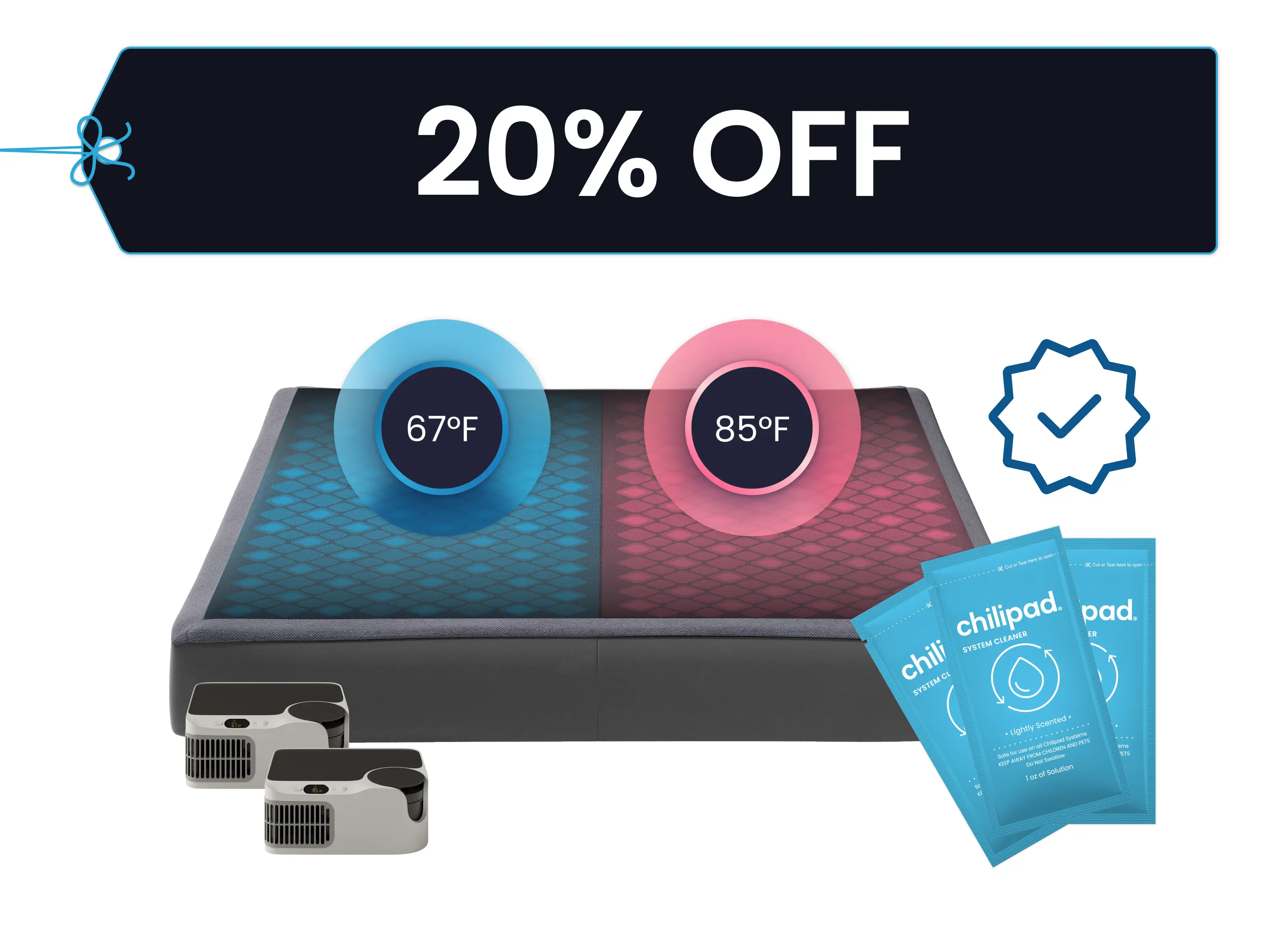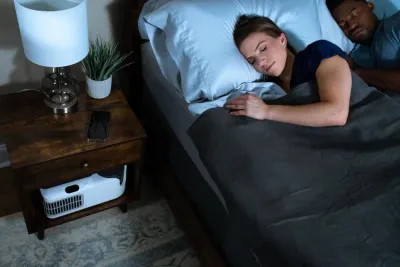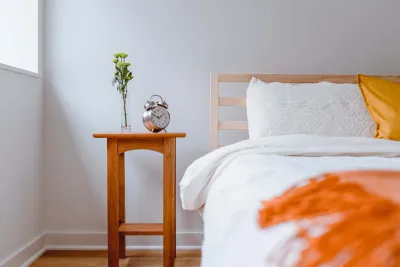PTSD and Sleep Problems: Understanding the Link and How to Break the Cycle
Chilipad Editorial Team • May 16, 2025

Key Takeaways
PTSD disrupts sleep by keeping the nervous system in a heightened state of alert, making it harder to fall asleep, stay asleep, and feel rested. Nightmares, hypervigilance, and anxiety are common contributors.
- PTSD commonly disrupts sleep, increasing the risk of insomnia, frequent awakenings, and recurring nightmares.
- Trauma affects brain systems tied to memory, stress response, and emotional regulation, which can keep the body stuck in a heightened alert state at night.
- Consistent sleep hygiene, calming bedtime routines, and relaxation techniques can help reduce nighttime hyperarousal.
- Support from partners or caregivers plays an important role in creating a safe, predictable sleep environment.
- Temperature regulation may improve sleep comfort and reduce night awakenings, making a cool, stable sleep setup especially helpful.
If you’ve ever laid in bed completely exhausted but unable to shut your mind off, especially if you are dealing with posttraumatic stress disorder, you’re not alone.
For those living with PTSD, sleep doesn’t always offer peace—it can feel like another battleground. The very act of closing your eyes can trigger nightmares, restlessness, or the crushing weight of memories you didn’t ask to relive.
In fact, sleep issues are among the most common and disruptive symptoms of Post-Traumatic Stress Disorder.
Whether it's chronic insomnia, hypervigilance, or recurring nightmares, poor sleep not only worsens PTSD symptoms—it can also block the path to healing altogether.
But there’s hope.
Understanding how PTSD affects the brain and body during sleep is the first step toward breaking this cycle. In this guide, we’ll explore why sleep becomes so complicated after trauma—and share real, actionable strategies to help reclaim the rest you deserve.
Understanding PTSD and How it Affects Sleep
Post-Traumatic Stress Disorder (PTSD) is a mental health condition triggered by experiencing or witnessing a traumatic event. It can manifest in various ways, including flashbacks, severe anxiety, and uncontrollable thoughts about the event.
One of the most debilitating aspects of PTSD is its impact on sleep. Research indicates that nearly 90% of individuals with Post-Traumatic Stress Disorder experience sleep disturbances, including trauma related nightmares, insomnia, and frequent nightmares. [1]
These sleep issues can exacerbate PTSD symptoms, creating a vicious cycle that affects overall well-being.
Create a Calmer Sleep Environment with Chilipad
Struggling with disrupted sleep from PTSD? The Chilipad Dock Pro offers precise temperature control to help calm your body and mind. By creating a cooler, more consistent sleep environment, it supports deeper, more restorative rest—night after night.
How Sleep Issues Affect PTSD Symptoms
Sleep disturbances can significantly worsen PTSD symptoms. Insomnia, characterized by difficulty falling or staying asleep, can lead to increased irritability, anxiety, and difficulty concentrating. Nightmares often replay traumatic events, causing distress and making it challenging for individuals to return to sleep.
This lack of restorative sleep can lead to heightened emotional responses, daytime sleepiness, and increased hyperarousal, further complicating the management of individuals living with PTSD.
The relationship between sleep and PTSD is reciprocal. Poor sleep can lead to increased symptoms, while the symptoms of PTSD can further disrupt sleep. This cycle can create a sense of hopelessness, making it even more challenging for individuals to seek help or find effective coping strategies.
How PTSD Affects Your Sleep
The relationship between Post-Traumatic Stress Disorder and sleep is complex. Individuals with PTSD often experience hyperarousal, which makes it difficult to relax and fall asleep. This heightened state of alertness can lead to restlessness and frequent awakenings throughout the night.
Additionally, disruptive nocturnal behaviors like nightmares and night terrors are common, often related to past trauma, leading to a fear of sleep itself. The cumulative effect of these sleep disturbances can result in chronic fatigue, impacting daily functioning and quality of life.
Research has shown that individuals with Post-Traumatic Stress Disorder may also experience disruptions in their sleep architecture, including alterations in REM sleep. [2] REM sleep is crucial for emotional memory processing, and disruptions in this stage can hinder the brain's ability to process traumatic experiences effectively.
This can lead to a cycle where unresolved trauma continues to affect sleep quality, creating a barrier to recovery.
Why PTSD Causes Sleep Problems
Researchers have also uncovered a strong connection between PTSD and sleep disorders. [3] A 2021 study highlights that people with PTSD often experience a range of sleep-related issues, including:
- Trouble falling or staying asleep (insomnia)
- Disturbing or vivid dreams tied to trauma
- Involuntary limb movements during sleep (similar to PLMD)
- Acting out dreams physically while asleep
- Episodes of waking up unable to move, sometimes with vivid hallucinations
- Breathing interruptions during sleep, often linked to obstructive sleep apnea (OSA) [4]
The Connection Between PTSD and the Brain
PTSD affects several brain regions responsible for processing memories and emotions, including the hippocampus, amygdala, and anterior cingulate cortex. Dysfunction in these areas can lead to symptoms such as flashbacks and hyperarousal.
The amygdala, which is involved in the processing of fear and emotional responses, may become overactive in individuals with PTSD, leading to heightened anxiety and stress responses.
Research shows that individuals with PTSD may exhibit a faster heart rate during sleep, indicating a persistent state of hypervigilance. [5] This hyperarousal can prevent individuals from entering deeper stages of sleep, which are essential for physical and mental restoration.
Furthermore, the chronic stress associated with PTSD can lead to increased levels of cortisol, a hormone that can disrupt sleep patterns and contribute to insomnia.

What Helps Improve Sleep With PTSD
Many people with PTSD find sleep especially challenging. Understanding how PTSD affects sleep and using gentle, practical strategies can make a big difference in getting more restful nights.
Sleep Hygiene
Think of sleep hygiene as setting the stage for better rest. Keep your room cool, dark, and quiet—basically, your personal sleep cave. Skip the late-night TV binges or working in bed, and save the space for sleep (and intimacy).
Small upgrades like blackout curtains, earplugs, or a white noise machine can make your bedroom feel like the ultimate reset zone.
Regular Sleep Schedule
Our bodies love routine—even if your social life doesn’t. Sticking to the same bedtime and wake-up time (yes, even on weekends) helps keep your internal clock on track.
The more consistent you are, the easier it is to fall asleep, stay asleep, and wake up feeling rested. Even small wins here can make a big difference.
Relaxation Techniques
Shutting down at night isn’t always easy, but giving your mind a signal to slow down makes a huge difference.
Try things like deep breathing, progressive muscle relaxation, or mindfulness—simple moves that can calm stress and prep you for sleep. Not your style?
Even reading, soaking in a warm bath, or taking a few quiet minutes to reset can help your brain shift from go mode to sleep mode.
Daily Exercise
Moving your body during the day pays off big at night. Regular exercise not only cuts stress but also makes it easier to drift off and stay asleep.
Shoot for about 30 minutes of activity most days. It doesn’t have to be hardcore. Just keep the high-intensity stuff earlier in the day, since late-night workouts can leave you feeling more wired than tired.
Prioritizing Deep Sleep
Deep sleep—also called slow-wave sleep—is where the real magic happens. This stage helps your body repair, your brain process memories, and your hormones stay balanced.
For people with PTSD, it’s especially important, since it plays a role in working through trauma and supporting recovery. When deep sleep gets cut short, everything from healing to focus takes a hit, which is why it’s something you can’t afford to miss.
Want mornings that actually feel refreshing? Focus on habits that boost your deep sleep.
Did You Know: Studies shows that people with both PTSD and sleep apnea may get better results from PTSD treatment when they use a CPAP machine to improve sleep quality. [6]
The Chilipad: Get Cooler Sleep
Keeping your bedroom cool isn’t just about comfort—it can actually help you sleep deeper and wake up less during the night.
That’s why the Chilipad Dock Pro and Cube were built to take control of your bed’s temperature, making it easier to get the kind of rest your body and mind need.
- Chilipad Dock Pro: Our best cooling mattress topper, dialing in temps from 55° to 115°F with app control for precision comfort. It cools you down fast, keeps you steady all night, and helps you wake up ready to go.
- Cube: The original cooling pad for your bed. Simple, reliable, and remote-controlled, the Cube holds your mattress between 60° and 115°F. No app, no fuss—just straightforward comfort to help you sleep cooler.
When to Seek Professional Help for PTSD and Sleep Issues
If sleep continues to be a struggle—for you or someone you care about—know that you don’t have to face it alone.
Reaching out to a healthcare provider for support, whether through cognitive behavioral therapy for insomnia (CBT-I) or PTSD-specific treatment, can make a real difference.
In some cases, sleep medications may be part of the journey, but always under professional guidance.
If you need help getting started, you can contact the National Alliance on Mental Illness (NAMI) HelpLine at 1-800-950-NAMI (6264) or visit nami.org/help for support and resources.

Helpful Tips for Partners of People with PTSD
Supporting a partner with PTSD sleep issues can be challenging, but your role is a vital part of their healing journey.
Here are a few thoughtful ways you can support them through the restless nights and every step of the journey beyond.
- Educate Yourself: Learn about Post-Traumatic Stress Disorder and its symptoms to better understand what your partner is experiencing. Understanding what they may be going through builds empathy and patience and helps you show up with the kind of support that truly makes a difference.
- Encourage Open Communication: Create a safe space for your partner to express their feelings and experiences. Listen without judgment and validate their emotions. Encourage them to share their needs and preferences regarding support.
- Promote Healthy Routines: Encourage your partner to establish a consistent sleep schedule and engage in relaxation techniques. Offer to join them in calming activities like meditation or gentle movement, not just to help them relax, but to remind them they’re not facing this alone.
- Be Patient: Recovery from PTSD is a gradual process. Understand that there may be setbacks and that your partner may need time and space to cope with their symptoms. Avoid taking their struggles personally, and remind them that healing takes time.
- Seek Support for Yourself: Supporting someone with Post-Traumatic Stress Disorder can be emotionally taxing. Consider seeking support from friends, family, or a therapist to help you navigate your feelings and maintain your well-being. This can also help you provide better support to your partner.
Helpful PTSD Resources
- National Alliance on Mental Illness (NAMI): (800) 950-NAMI (6264). Available Monday through Friday between 10 a.m. and 6 p.m. EST, hotline staff are prepared to answer any mental health questions you may have. If you prefer, you can also text NAMI to 741741 for free support.
- Substance Abuse and Mental Health Services Administration (SAMHSA): (800) 662-HELP (4357). Available 24/7, 365 days a year, the professionals on the phone can provide treatment information and referrals in English and Spanish to people who have questions about mental health or substance abuse disorders.
- Mentalhealth.gov: (877) 726?4727. This hotline is available between 8 a.m. and 8 p.m. EST to provide mental health information and treatment referrals.
- National Institute of Mental Health (NIMH): 1-866-615-6464(toll-free), 1-301-443-8431 (TTY), or 1-866-415-8051 (TTY toll-free). Available between 8:30 a.m. and 5 p.m. EST, professionals can answer any mental health-related question in English or Spanish and attend to requests for copies of NIMH brochures.
Conclusion
Navigating the challenges of PTSD sleep problems can feel overwhelming, but you're not alone. Understanding how trauma and sleep are connected is the first step toward breaking the cycle and finding real relief.
By implementing effective sleep hygiene practices, relaxation techniques, and seeking professional help, individuals with PTSD can improve their sleep quality and overall well-being. Partners play a vital role in this journey, providing support and understanding as their loved ones work through their symptoms.
Improving sleep is not just about getting more hours of rest; it is about enhancing the quality of that rest. With the right strategies and support, individuals with PTSD can break the cycle of sleep disturbances and reclaim their nights, leading to a more fulfilling and balanced life.
Remember, seeking help is a sign of strength, and taking proactive steps toward better sleep can significantly impact recovery and overall mental health.
Frequently asked questions
How Does PTSD Affect Sleep?
PTSD can interfere with sleep in multiple ways, including:
- Insomnia
- Nightmares
- Night terrors
- Heightened nighttime anxiety
- Hyperarousal
Can Poor Sleep Make PTSD Symptoms Worse?
Absolutely. Lack of quality sleep can amplify symptoms like irritability, anxiety, and emotional reactivity, creating a vicious cycle that makes PTSD harder to manage.
How Can a Partner or Loved One Help?
Support starts with understanding. Educate yourself, listen without judgment, and help your loved one create a safe, calming sleep environment. Your presence can offer comfort through even the toughest nights.
References
[1] Koffel, Erin et al. “Sleep Disturbances in Posttraumatic Stress Disorder: Updated Review and Implications for Treatment.” Psychiatric annals vol. 46,3 (2016): 173-176. doi:10.3928/00485713-20160125-01 View Study
[2] Barone, Daniel A. “Dream enactment behavior-a real nightmare: a review of post-traumatic stress disorder, REM sleep behavior disorder, and trauma-associated sleep disorder.” Journal of clinical sleep medicine : JCSM : official publication of the American Academy of Sleep Medicine vol. 16,11 (2020): 1943-1948. doi:10.5664/jcsm.8758. View Study
[3]Lancel, Marike et al. “Disturbed Sleep in PTSD: Thinking Beyond Nightmares.” Frontiers in psychiatry vol. 12 767760. 24 Nov. 2021, doi:10.3389/fpsyt.2021.767760. View Study
[4] Ibid.
[5] Simon, Lisa, et al. “Stress-Induced Increase in Heart-Rate during Sleep as an Indicator of PTSD Risk among Combat Soldiers.” SLEEP, 7 Aug. 2024. View Study
[6] El-Solh, Ali A et al. “The effect of continuous positive airway pressure on post-traumatic stress disorder symptoms in veterans with post-traumatic stress disorder and obstructive sleep apnea: a prospective study.” Sleep medicine vol. 33 (2017): 145-150. doi:10.1016/j.sleep.2016.12.025. View Study









